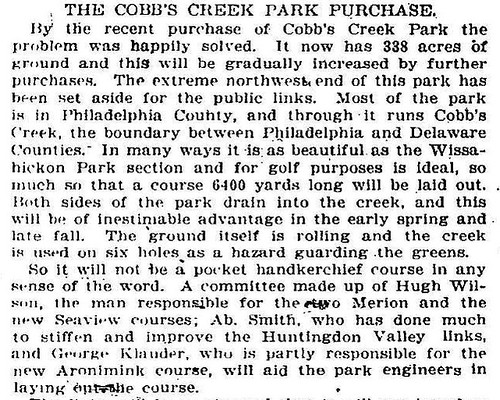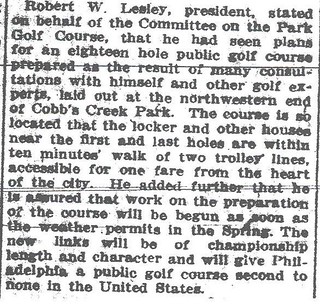Posted on behalf of Mike Cirba
All,
I haven't had the opportunity to read to much in the past day or so, but I did see a picture of the old "Tie-Fighter" green as Geoff Walsh dubbed it and noted that Patrick Mucci instantly saw the same comparison that I did...to the old 12th at Garden City. It also bears close relation to a similar greensite Walter Travis did at Columbia. With that in mind, some months back when I was still on the site I speculated that this might have been a contribution by Walter Travis to Cobb's Creek, simply because it is such a complete "one-off" from virtually every other greensite created there, most of which are very low-profile. I further speculated that this might have been a particularly troublesome area for construction, as most of the land right around there slopes away very steeply, and is the site of where very visible earthmoving took place (for instance, to create today's 13th tee).
Now, as the guy in charge of features, I'm thinking that William Flynn was at least physically and mentally capable of creating something like this, particularly with Travis's instructions. Do we know? No, of course we don't, but we know both Flynn and Travis were involved and have documentation providing those facts.
What I find a bit "interesting" is that since that picture was posted, after Patrick's response some now seem to see value in that hole. If memory serves, it was posted previously by the same folks and used as an object of ridicule. At that time, when I posted pics of the greens at Garden City and at Columbia I was assured that I was indeed an idiot, out of my mind, and probably disengenous, as well.


No matter, all's for the better forward progress as they say!
I also see where Tom MacWood questions my judgment of his interpretation of the William Evans article. Perhaps if I just show the parapraphs in question I can explain better.
Now, Tom reads the following January 31st, 1915 article as indicating that only Hugh Wilson, Ab Smith, and George Klauder designed the golf course. I think he makes a basic mistake here, as the course was already routed seven months prior to then as I will show in a moment. But here are the two paragraphs back to back, and I think you'll see what I mean.
We see in the first paragraph clear indication that the course has been routed as Evans tells us that the creek is used "on six holes as hazards guarding the greens".
Then, in the next paragraph, we see the mention of the three men who "will aid" (future tense) "the park engineers in laying out the course", which clearly means the construction process by that late date.

Now, I'm not certain that these were the only three men involved in the construction process as just a few days later, on February 8th, 1915, a special GAP meeting is held and appointed a "Park Golf Committee" to work in conjunction with the Park Commissioners. Strangely, Hugh Wilson's name is not on there, but we know from other accounts that he was heavily involved in the construction process;

Almost a year later, on January 9th, 1916, with construction complete and the course set to open the following spring, Joe Bunker wrote the following, speaking of Ellis Gimbel of Philmont;

Yet, I have no doubt that from a construction standpoint, that work was almost all Hugh Wilson, George Klauder, and Ab Smith, working with William Flynn (who was superintendent of two courses at Merion at the time and was doing this with likely permission of Winthrop Sargent, who was Merion's Head of Greens Committee at the time. Over the winter, with the course set fo open the following spring, the GAP acknowledged their efforts at the annual conference. It is important to keep in mind that in 1916 Merion would host the US Amateur, after a significant number of architectural improvements implemented by Hugh Wilson and William Flynn.

This article talks about the amount of time spent by Wilson and Smith during the construction process to get the course ready
after the plans were decided upon;

So, how and when did the plans get created in the first place? It might be helpful to step back and timeline these steps;
First, in February of 1913, shortly after Merion's East course was opened for play and right after approval was given to create Merion West, as well as right after George Crump had purchased 184 acres the previous autumn and was hard at work trying to locate golf holes, both men were appointed by GAP along with Ab Smith, who had done extensive toughening of Huntingdon Valley, as well as Joseph Slattery of Whitemarsh Valley to "a committee of experienced golfers", as one news account called them, charged with finding a location for a public golf course within the Philadelphia park system. Other news accounts referred to them as "expert golfers'.

The committee first recommended a site in Fairmount Park for a nine hole course (expandable to 18) near Belmont Mansion, and in April of that year a number of members of GAP met with Park Commissioners to go over the land in question. Everyone was at first optimistic, but when the matter was taken to a vote two months later in June of that year, concerns were raised about safety and no funds were available from the Fairmount Park Commission directly.
However, it appears that the Committee had already found their Plan B...a site in Cobb's Creek, which the committee termed "ideal". Indeed, at that time the Fairmount Park Commission approved asking Council to appropriate $30,000 for the purpose. From the Fairmount Park Commission Meeting minutes of June 1913;


At the time, AW Tillinghast wrote;
"The Commission decided that there was no available place in Fairmount Park for a public golf course. The Committee on Police and Superintendence, through its chairman, Eli K. Price, suggested instead that Councils be asked to appropriate $30,000 to establish a free golf course in Cobb's Creek Park, where there is an unbroken tract of 91 acres available for an 18-hole golf course."
"Mr. Price declared the subject had been thoroughly investigated by the committee, and that it had been agreed there was not enough available land for an 18-hole course in the Park. The committee, he declared, had learned that it would require about $15,000 to lay out a course along Cobb's Creek, $15,000 to build locker houses and $10,000 for its yearly maintenance. The committee, therefore, requested the Commission to ask Councils to set aside $30,000 for this purpose. The request was adopted." Another account from the period;

Unfortunately at the time, Council failed to act and other sites were considered. In December of 1913, Tillinghast reported;
Those who have been working for a Philadelphia public golf course have not permitted the first rebuff to dishearten them nor have they been inactive. President Robert Lesley, of the Golf Association of Philadelphia, asserts that the city will have the course, and in Fairmount Park, too.
The committee believes that a tract close by Cobb's Creek is suited nicely to the requirements. Finally, in April of 1914 Council appropriated the monies for the course at Cobb's Creek. Sometime that spring it appears the routing was completed, because the following news account appeared in June of 1914;

Still, with appropriations hung up in the budget process, it wasn't until January of that year that the good news could finally be announced by President Robert Lesley at the GAP annual meeting;


Subsequent accounts of the creation of the golf course and the men involved included this from two weeks prior to course opening;

This one is from "Peter Putter" in 1917;

This one from 1921;

This one from William Evans in 1922;

This one from Joe Dey in 1928;

There is a remarkable amount of documentation around this project, most found by the amazing Mr. Bausch, researcher extraordinaire.
I really can't imagine for the life of me why anyone thinks we shouldn't have provided all of this amazing history to our readers and interested parties, or omit any of these talented men who gave of their time and efforts to create the golf course. Thanks to everyone for your wonderful support and interest.
And finally, another article that gives some idea of the course's reputation before the Depression years, this from 1928;
